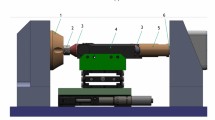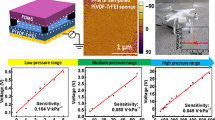Abstract
A dynamic experimental technique that is three orders of magnitude as sensitive in stress measurement as a conventional split Hopkinson pressure bar (SHPB) has been developed. Experimental results show that this new method is effective and reliable for determining the dynamic compressive stress-strain responses of materials with low mechanical impedance and low compressive strengths, such as elastomeric materials and foams at high strain rates. The technique is based on a conventional SHPB. Instead of a surface strain gage mounted on the transmission bar, a piezoelectric force transducer was embedded in the middle of the transmission bar of a high-strength aluminum alloy to directly measure the weakly transmitted force profile from a soft specimen. In addition, a pulse-shape technique was used for increasing the rise time of the incident pulse to ensure stress equilibrium and homogeneous deformation in the low-impedance and low-strength specimen.
Similar content being viewed by others
References
Kolsky H., “An Investigation of Mechanical Properties of Materials at Very High Rates of Loading,”Proc. Phys. Soc. Lon. Ser. B,62,676–700 (1949).
Follansbee, P.S., “The Hopkinson Bar,”Mechanical Testing, Metals Handbook,8,9th ed.,American Society for Metals,Metals Park, OH,198–217 (1985).
Ross, C.A., Jerome, D.M., Tedesco, J.W. andHughes, M.L., “Moisture and Strain Rate Effects on Concrete Strength,”ACI Mat. J.,93,293–300 (1996).
Chen, W. andRavichandran, G., “Dynamic Compressive Failure of a Glass Ceramic under Lateral Confinement,”J. Mech. Phys. Solids,45,1303–1328 (1997).
Chen, W., Zhang, B., andForrestal, M.J., “A Split Hopkinson Bar Technique for Low-impedance Materials,” EXPERIMENTAL MECHANICS,39,81–85 (1999).
Gamby, D. andChaoufi, J., “Asymptotic Analysis of Wave Propagation in a Finite Viscoplastic Bar,”Acta Mech.,87,163–178 (1991).
Wang, L., Labibes, K., Azari, Z., andPluvinage, G., “Generalization of Split Hopkinson Bar Technique to Use Viscoelastic Bars,”Int. J. Impact Eng.,15,669–686 (1994).
Bragov, A.M. andLomunov, A.K., “Methodological Aspects of Studying Dynamic Material Properties Using the Kolsky Method,”Int. J. Impact Eng.,16,321–330 (1995).
Zhao, H., Gary, G., andKlepaczko, J.R., “On the Use of a Viscoelastic Split Hopkinson Pressure Bar,”Int. J. Impact Eng.,19,319–330 (1997).
Knauss, W.G., Boyce, M., McKenna, G., andWineman, A., “Nonlinear, Time-dependent Constitution of Engineering Polymers,”Report No. 95-10, Institute for Mechanics and Materials, University of California, San Diego, 1–16 (1995).
Graham, R.A., “Technique for Studying Piezoelectricity under Transient High Stress Conditions,”Rev. Sci. Instr.,32,1308–1313 (1961).
Wasley, R.J., Hoge, K.G., andCast, J.C., “Combined Strain Gaugequartz Crystal Instrumented Hopkinson Split Bar,”Rev. Sci. Instr.,40,889–894 (1969).
Karnes, C.H. andRipperger, E.A., “Strain Rate Effects in Cold Worked High-purity Aluminum,”J. Mech. Phys. Solids,14,75–88 (1966).
Chalupnik, J.D. andRipperger, E.A., “Dynamic Deformation of Metals under High Hydrostatic Pressure,” EXPERIMENTAL MECHANICS,6,547–554 (1966).
Togami, T.C., Baker, W.E., andForrestal, M.J., “A Split Hopkinson Bar Technique to Evaluate the Performance of Accelerometers,”Trans. ASME, J. Appl. Mech.,63,353–356 (1996).
The User's Guide to Ultrasound and Optical Products, Valpey-Fisher, Hopkinton, MA (1996).
Chen, W. andZhang, X., “Dynamic Response of Epon 828/T-403 under Multiaxial Loading at Various Temperatures,”J. Eng. Mat. Tech., Trans. ASME,119,305–308 (1997).
RTV630 High Strength Silicone Rubber GE Silicones Waterford, NY (1999).
Wu, X.J. andGorham, D.A., “Stress Equilibrium in the Split Hopkinson Pressure Bar Test,”J. Physique IV, Colloque C3,7,91–96 (1997).
Gray, G.T. III, Blumenthal, W.R., Trujillo, C.P., andCarpenter, R.W. II, “Influence of Temperature and Strain Rate on the Mechanical Behavior of Adiprene L-100,”J. Physique IV, Colloque C3,7,523–528 (1997).
Author information
Authors and Affiliations
Rights and permissions
About this article
Cite this article
Chen, W., Lu, F. & Zhou, B. A quartz-crystal-embedded split Hopkinson pressure bar for soft materials. Experimental Mechanics 40, 1–6 (2000). https://doi.org/10.1007/BF02327540
Received:
Revised:
Issue Date:
DOI: https://doi.org/10.1007/BF02327540




